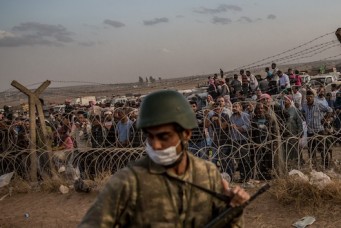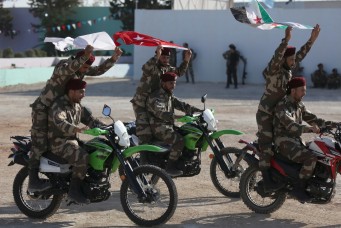Securing The Syrian Regime
The Syrian regime’s institutionalization of local militias bolsters their loyalty and ensures the regime’s hold on the militias’ communities.

Independent groups fighting on the side of the Syrian regime have emerged and grown in size and influence over the last three years. These groups could pose a genuine danger to the regime if they were to get out of its control. If they gained a significant following on the ground and links to society, they would be able to negotiate with the regime for control and power and to work with foreign actors for their own interests, potentially against those of the regime. The regime’s priority over the past year has been to contain these groups by institutionalizing them to ensure their loyalty—a key component of a successful survival strategy.
The biggest of these groups is the National Defense Force (NDF), which was founded as a civilian force in Homs in late 2012 to fight alongside the Syrian Army and security forces; its structure later spread throughout Syria. However, prior to that, the NDF did not play a security role. Rather, its forces were originally created as informal popular committees (lijan shaabiyya), centered in villages and neighborhoods and aimed at protecting their own local areas. This was particularly important during the early days of the uprising: by drawing in youths from a given area, the committees categorized particular neighborhoods as loyal to the regime, distinguishing these from neighborhoods where youth engaged in protests and were disloyal to the regime.
As violence increased in mid-2012, the local committees became more deeply involved in fighting. Their growth on the ground began to present a potential danger to the regime. At this point, to ensure the committees’ ongoing engagement and loyalty, the regime began the process of institutionalizing these groups. These bodies within the NDF sprang up among many different segments of Syrian society, contrary to the assumption outside Syria that the NDF and other militias are entirely or mainly Alawite. Rather, as wholly localized bodies, they draw from the same sect, tribe, or neighborhood in which they are based. In Sweida and Jaramana, for example, they are comprised overwhelmingly of Druze, of Alawites in Homs and Latakia, Christians in Wadi al-Nasara, and Sunnis (particularly Arab clans) in Aleppo and its environs. They have also come to reflect local society in that their ranks draw on local civilians and retired professional soldiers, not military personnel on active duty. The leader of the NDF in Homs, for example, was a civil engineer and not a professional soldier before the uprising.
The creation of the NDF transformed and assembled these fighting groups into formal regiments under the support and control of the state. This process began in late 2012 and continued incrementally over the course of several months. The government slowly gave the fighting groups material support and recognition so that, by spring 2013, they existed as a formal institution. The NDF has secured administrative buildings for its leadership, training centers, an official stamp, standardized uniforms, a motto and flag, and monthly salaries. Weapons, salaries, and direction come from Damascus. The extent to which this strategy of institutionalization has succeeded is evident in the events following the March 23, 2014 killing of Hilal al-Assad, the leader of the Latakia National Defense Force. Rather than descending into internecine strife upon his death—as the cronies of a warlord might do—the National Defense Force in Latakia has kept up its existing institutional frame.
Other non-military local groups and associations to support the fighting forces have also emerged, further enmeshing civilians in state institutions. The Syrian Martyrs’ Association, founded in mid-2013, is a prime example. Though not exclusively for NDF veterans, it plays an important role in providing them services. The association builds hospitals, arranges funeral services and burials, plans leisure activities for children at schools, and provides material support to the families of members of the NDF. Several associations providing similar services have also arisen; all of them are composed of members of the local communities, just like the NDF. Also like the NDF, they have received official licenses from the Ministry of Work and Social Affairs; they even have bank accounts in the Syrian Commercial Bank to accept donations from members of society.
Members of the Martyrs’ Association and the NDF come from similar backgrounds; they are civilian, not military, and they come from the same local community. There is a tight linkage between members of the association and the NDF because fighters come from the same region, and often sect, as the local members of the association. The same family will often be involved in both activities—sending fighters to the NDF and supporting or being supported by the association. The presence of this association creates a general feeling of security inside the society for these fighters. It assures them that they are protected and that there is another civilian party that will support them and their families in the event of their injury or death. The organizations that have sprung up to support fighters and their families, by receiving official sanction, further draw the irregular fighting forces under the umbrella of the Syrian state. These linkages ensure that militias currently working for the state are deeply entwined with the Syrian regime.
Institutionalizing the groups that practiced violence at the beginning of the revolution and subordinating them within the frame of the state reflects an effective strategy of the Syrian regime to cope with the war. In doing so, the regime gained considerable leverage over these fighters. Their destiny is now linked to that of the regime, and the local societies from which the groups emerge are therefore also linked to the regime. For this reason, we are unlikely to see the leaders of these groups rebel against the Syrian state, at least not in the foreseeable future.
This article is reprinted with permission from Sada. It can be accessed online at:http://carnegieendowment.org/sada/2014/06/03/securing-syrian-regime/hcg0
Kheder Khaddour is a visiting scholar at Carnegie’s Middle East Center in Beirut.



